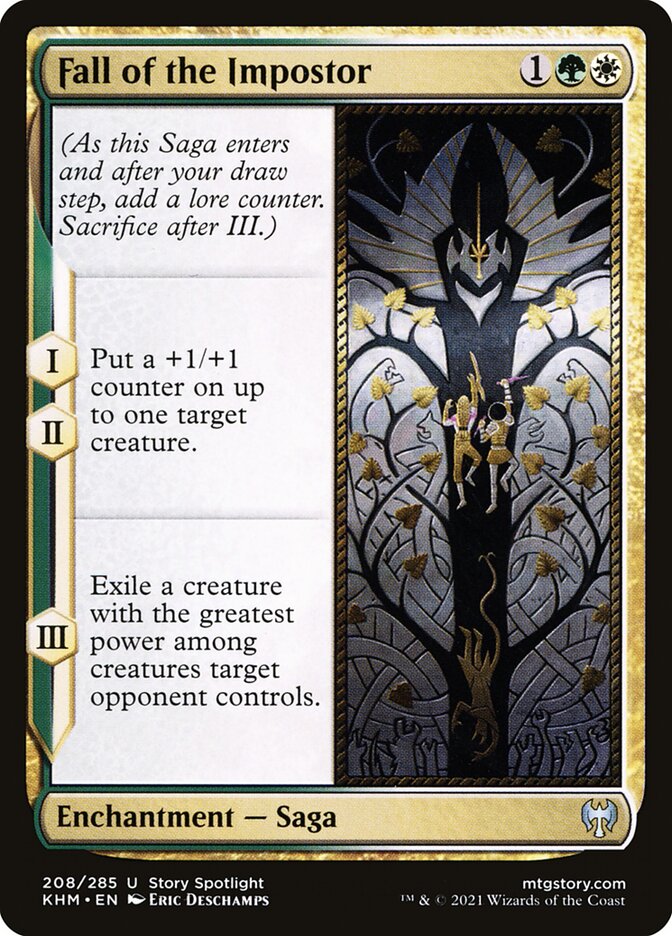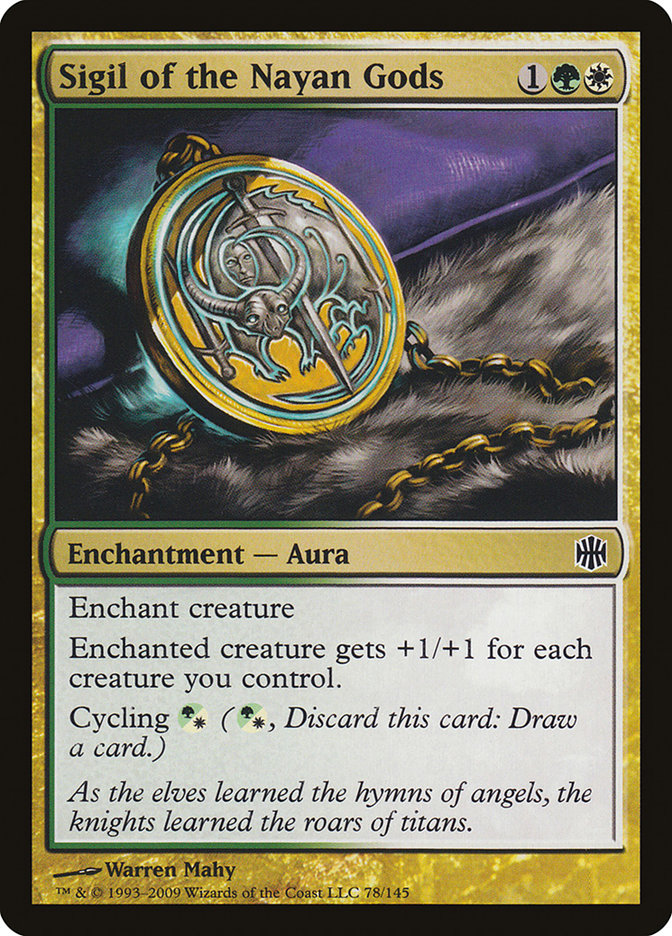Fall of the Impostor MTG Card
| Mana cost | |
| Converted mana cost | 3 |
| Rarity | Uncommon |
| Type | Enchantment — Saga |
| Released | 2021-02-05 |
| Set symbol | |
| Set name | Kaldheim |
| Set code | KHM |
| Number | 208 |
| Frame | 2015 |
| Layout | Saga |
| Border | Black |
| Illustred by | Eric Deschamps |
Text of card
(As this Saga enters and after your draw step, add a lore counter. Sacrifice after III.) I, II — Put a +1/+1 counter on up to one target creature. III — Exile a creature with the greatest power among creatures target opponent controls.
Cards like Fall of the Impostor
Fall of the Impostor is an intriguing saga card in Magic: The Gathering’s vast library. It mirrors the functionality of cards like Banishing Light and Oblivion Ring, which are known for their exile target nonland permanent features. The saga unfolds over three turns, with the first two lore counters offering creature enhancement, akin to the bolstering effects of cards like Ajani’s Welcome. The third lore counter, however, propels it into the company of aforementioned exilers, though with a delayed gratification angle.
Another card worth mentioning in connection with Fall of the Impostor is Oath of the Ancients. While not a saga, this enchantment card also focuses on growth, but it allows for a more immediate impact by granting a counter as soon as it arrives and each subsequent upkeep. Finally, The Eldest Reborn stands in contrast to Fall of the Impostor with its saga unfolding along a darker narrative – spelling doom for opponents’ creatures and ultimately resurrecting creatures or planeswalkers from graveyards.
By evaluating the nuanced interplay of delay versus immediacy, and growth versus revival, Fall of the Impostor carves its niche within Magic: The Gathering as a saga that combines creature enhancement with a strategic delay in removal power.
Cards similar to Fall of the Impostor by color, type and mana cost
Card Pros
Card Advantage: Fall of the Impostor can prove pivotal in sculpting the battlefield to your favor. Over its existence on the field, this saga not only nurtures your own creatures but eventually exiles an opponent’s threat, tipping the scales in card presence and board control.
Resource Acceleration: By placing two +1/+1 counters on one of your creatures over two turns, Fall of the Impostor accelerates your resources by enhancing creature potential without the need for additional spells. Improved creatures can mean earlier and more impactful attacks or better defenses that apply pressure or protect your life total.
Instant Speed: While not at instant speed, the saga’s final chapter can be surprisingly adaptable. Timing the exile of an opponent’s creature to occur just before your turn ensures you maintain the initiative, potentially removing a newly cast threat or an activated ability-based nuisance without the delay typical of sorcery speed.
Card Cons
Discard Requirement: In the case of Fall of the Impostor, while there’s no direct discard requirement, the saga’s third chapter requires sacrificing it. This could be seen as a trade-off if you’re aiming for long-term board presence.
Specific Mana Cost: The card’s casting cost demands a white and a green mana, which could restrict its inclusion to decks that reliably produce both types of mana. This specificity might not fit into a multicolor strategy that doesn’t prioritize these colors.
Comparatively High Mana Cost: With a casting cost of three mana, some players may argue that the return on investment comes too slowly, as it’s spread across three turns. The immediate impact on the game is minimal, which can be a drawback in fast-paced games where immediate board presence is critical.
Reasons to Include Fall of the Impostor in Your Collection
Versatility: Fall of the Impostor offers a flexible solution for deck building, as it serves as both a creature booster and a conditional removal. Its capability to strengthen your creatures over time before potentially removing a threat makes it a valuable addition to various deck archetypes, particularly those focused on +1/+1 counters.
Combo Potential: This card can be pivotal in decks that exploit +1/+1 counters, working seamlessly with cards that benefit from counters or require them to activate abilities. Its incremental growth paired with a final removal effect can turn the tides in a game, making it a great combo enabler.
Meta-Relevance: With creature-based strategies proliferating in the current meta, Fall of the Impostor can be a timely addition. The card’s ability to enhance your creatures and potentially neutralize opponents’ key threats aligns well with the evolving dynamics of gameplay, making it a card worth considering for its strategic value in matchups.
How to beat
Fall of the Impostor is a unique Saga card that players can find tricky to navigate around in Magic: The Gathering. It has three distinct abilities that trigger over successive turns, providing incremental advantages to the controller. The card functions by placing a +1/+1 counter on a creature you control on its first and second chapters, and on the third, it removes a threat by forcing a player to sacrifice a creature with the greatest power among creatures they control.
To effectively counter Fall of the Impostor, players should consider holding on to instant-speed removal to disrupt the saga’s final chapter. Aquiring instant-speed capabilities allows you to react to the saga’s third chapter by removing your own creatures with smaller power, ensuring the sacrifice has a minimal impact on your board. Alternatively, utilizing enchantment removal after the first or second chapter can prevent the final, most detrimental chapter from occurring. It’s essential to evaluate the board state and determine the best moment to act, cutting the saga’s impact short. Planning ahead can make Fall of the Impostor less imposing.
In summary, to beat Fall of the Impostor, swift action is key, whether through targeted creature removal or enchantment disruption, to minimize the advantages gained by your opponent. Your strategic foresights can turn the tide of the game despite the incremental benefits given by this saga to your adversary.
BurnMana Recommendations
Mastering the ins and outs of Fall of the Impostor is crucial for any strategic MTG player. Appreciating the value of +1/+1 counters along with the precise timing for exiling threats can shape your game-plan into a winning strategy. Whether you aim to enhance your creatures’ power gradually or neutralize your opponent’s key threats, integrating this saga into your deck is a step towards optimizing your gameplay. For those keen on fine-tuning their deck-building skills and learning more about leveraging cards like Fall of the Impostor in competitive play, our platform is your go-to resource. Dive deep into strategic insights and raise your game with us.
Where to buy
If you're looking to purchase Fall of the Impostor MTG card by a specific set like Kaldheim, there are several reliable options to consider. One of the primary sources is your local game store, where you can often find booster packs, individual cards, and preconstructed decks from current and some past sets. They often offer the added benefit of a community where you can trade with other players.
For a broader inventory, particularly of older sets, online marketplaces like TCGPlayer, Card Kingdom and Card Market offer extensive selections and allow you to search for cards from specific sets. Larger e-commerce platforms like eBay and Amazon also have listings from various sellers, which can be a good place to look for sealed product and rare finds.
Additionally, Magic’s official site often has a store locator and retailer lists for finding Wizards of the Coast licensed products. Remember to check for authenticity and the condition of the cards when purchasing, especially from individual sellers on larger marketplaces.
Below is a list of some store websites where you can buy the Fall of the Impostor and other MTG cards:
 BUY NOW
BUY NOW BurnMana is an official partner of TCGPlayer
- eBay
- Card Kingdom
- Card Market
- Star City Games
- CoolStuffInc
- MTG Mint Card
- Hareruya
- Troll and Toad
- ABU Games
- Card Hoarder Magic Online
- MTGO Traders Magic Online
See MTG Products
Legalities
Magic the Gathering formats where Fall of the Impostor has restrictions
| Format | Legality |
|---|---|
| Commander | Legal |
| Legacy | Legal |
| Modern | Legal |
| Oathbreaker | Legal |
| Vintage | Legal |
| Duel | Legal |
| Explorer | Legal |
| Gladiator | Legal |
| Pioneer | Legal |
| Timeless | Legal |
Rules and information
The reference guide for Magic: The Gathering Fall of the Impostor card rulings provides official rulings, any errata issued, as well as a record of all the functional modifications that have occurred.
| Date | Text |
|---|---|
| 2021-02-05 | A chapter ability doesn’t trigger if a lore counter is put on a Saga that already had a number of lore counters greater than or equal to that chapter’s number. For example, the third lore counter put on a Saga causes the chapter III ability to trigger, but chapters I and II won’t trigger again. |
| 2021-02-05 | As a Saga enters the battlefield, its controller puts a lore counter on it. As your precombat main phase begins (immediately after your draw step), you put another lore counter on each Saga you control. Putting a lore counter on a Saga in either of these ways doesn’t use the stack. |
| 2021-02-05 | Each symbol on the left of a Saga’s text box represents a chapter ability. A chapter ability is a triggered ability that triggers when a lore counter that is put on the Saga causes the number of lore counters on the Saga to become equal to or greater than the ability’s chapter number. Chapter abilities are put onto the stack and may be responded to. |
| 2021-02-05 | If multiple chapter abilities trigger at the same time, their controller puts them on the stack in any order. If any of them require targets, those targets are chosen as you put the abilities on the stack, before any of those abilities resolve. |
| 2021-02-05 | If the target player controls more than one creature tied for the greatest power among creatures that player controls, you choose which one of them is exiled. |
| 2021-02-05 | Once a chapter ability has triggered, the ability on the stack won’t be affected if the Saga gains or loses counters, or if it leaves the battlefield. |
| 2021-02-05 | Once the number of lore counters on a Saga is greater than or equal to the greatest number among its chapter abilities, the Saga’s controller sacrifices it as soon as its chapter ability has left the stack, most likely by resolving or being countered. This state-based action doesn’t use the stack. |
| 2021-02-05 | Removing lore counters won’t cause a previous chapter ability to trigger. If lore counters are removed from a Saga, the appropriate chapter abilities will trigger again when the Saga receives more lore counters. |
| 2021-02-05 | The chapter III ability doesn’t target any creatures. For example, a creature with protection from white could be exiled this way. |
| 2021-02-05 | The greatest power among creatures target opponent controls is determined solely by evaluating the creatures that player controls at that time. You won’t consider creatures controlled by any other player. |














